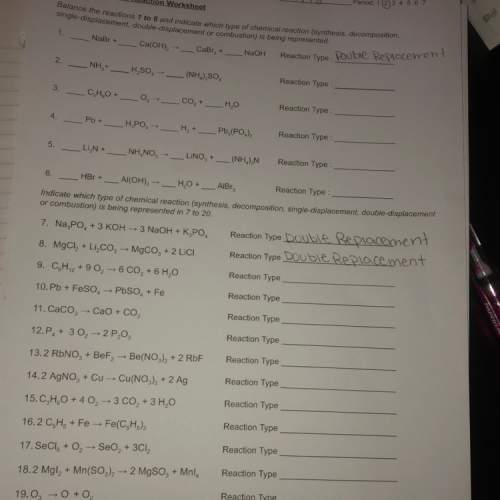
Chemistry, 16.04.2020 18:25 mahkitheking16
A weather balloon is inflated to a volume of 29.5 L at a pressure of 742 mmHg and a temperature of 23.0 ∘C. The balloon rises in the atmosphere to an altitude where the pressure is 400. mmHg and the temperature is -15.3 ∘C. Assuming the balloon can freely expand, calculate the volume of the balloon at this altitude.

Answers: 2


Another question on Chemistry

Chemistry, 22.06.2019 07:40
22. a flask containing 450 ml of 0.50 m h2so4 was accidentally knocked to the floor. how many grams of nahco, do you need to put on the spill to neutralize the acid according to the following equation: h2so4(aq)+2 nahcos(aq) na,so(aq) +2 h20()+2 co2(g) d) 38 g a) 2.3 g b) 9.5 g c) 19 g
Answers: 1

Chemistry, 22.06.2019 12:00
Under normal conditions, describe how increasing the temperatures effects the solubility of a typical salt
Answers: 1

Chemistry, 22.06.2019 15:30
Plz me ! 1 which of earths spheres contains most of its mass? a atmosphere b hydrosphere c geosphere* d biosphere 2 erosion and weathering are examples of which types of forces? a constructive forces b destructive forces* c gravitational forces d inertia-related forces 3 which of the following statements about earths atmosphere is true? a earths atmosphere contains 78% water vapor which is essentail to life b earths atmosphere contains 21% oxygen c earths atmosphere contains carbon dioxide which all life forms require d earths atmosphere allows radiation from the sun to pass through it and warm earths surface* 4 the strenght of the force of gravity between two objects is determined by which of the following factors? select all that apply a the messes of the objects* b the distance between the objects* c the volumes of the objects d the surface area of the objects 5 earth and moon are kept in there respective orbits due to the influence of a inertia b gravity c gravity and inertia* d neither gravity or inertia if you answer all questions right i will give
Answers: 1

Chemistry, 22.06.2019 19:20
Consider hydrogen in an excited state n = 5n=5 that emits photons to reach the ground state. there are various possible transitions other than straight to the ground state that can occur; for example, it can drop to the n = 3n=3 state followed by the n = 3n=3 to the ground state transition. which of the possible transitions will result in the emission of a photon in the visible region?
Answers: 3
You know the right answer?
A weather balloon is inflated to a volume of 29.5 L at a pressure of 742 mmHg and a temperature of 2...
Questions

Mathematics, 14.01.2020 23:31

Mathematics, 14.01.2020 23:31

History, 14.01.2020 23:31


Biology, 14.01.2020 23:31


Mathematics, 14.01.2020 23:31

Mathematics, 14.01.2020 23:31


Mathematics, 14.01.2020 23:31

English, 14.01.2020 23:31


Health, 14.01.2020 23:31

Social Studies, 14.01.2020 23:31

History, 14.01.2020 23:31

Mathematics, 14.01.2020 23:31


History, 14.01.2020 23:31

Mathematics, 14.01.2020 23:31




